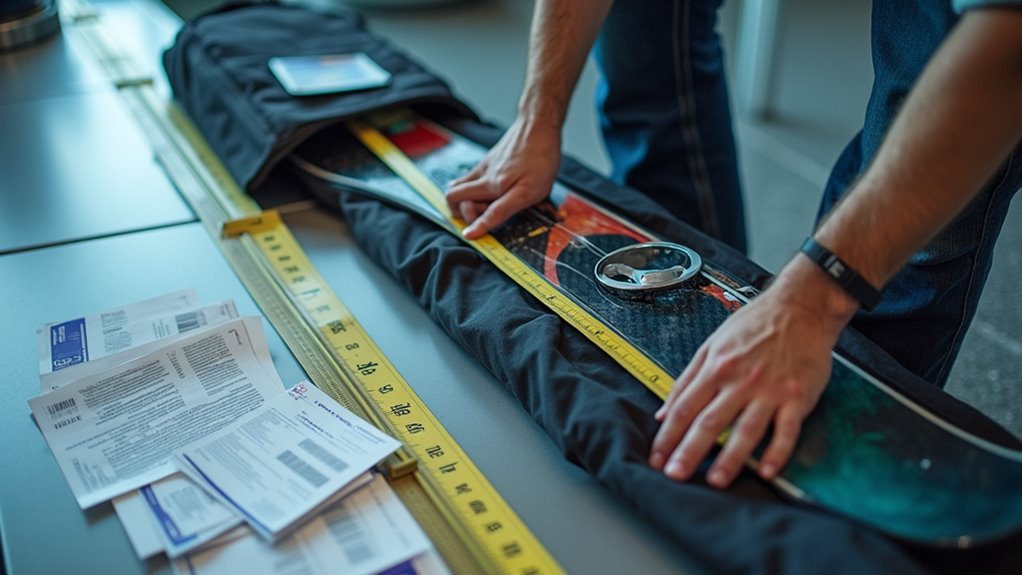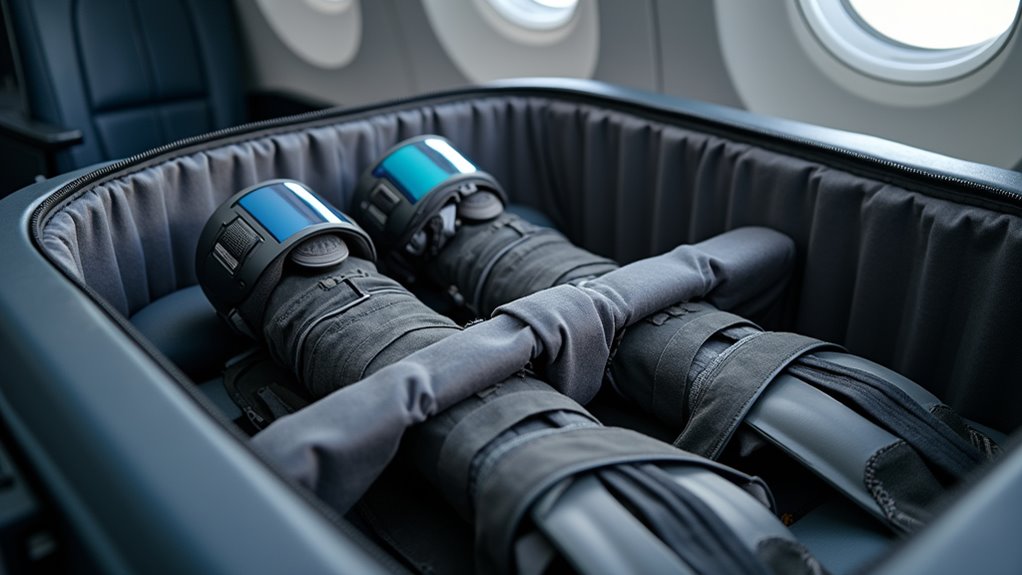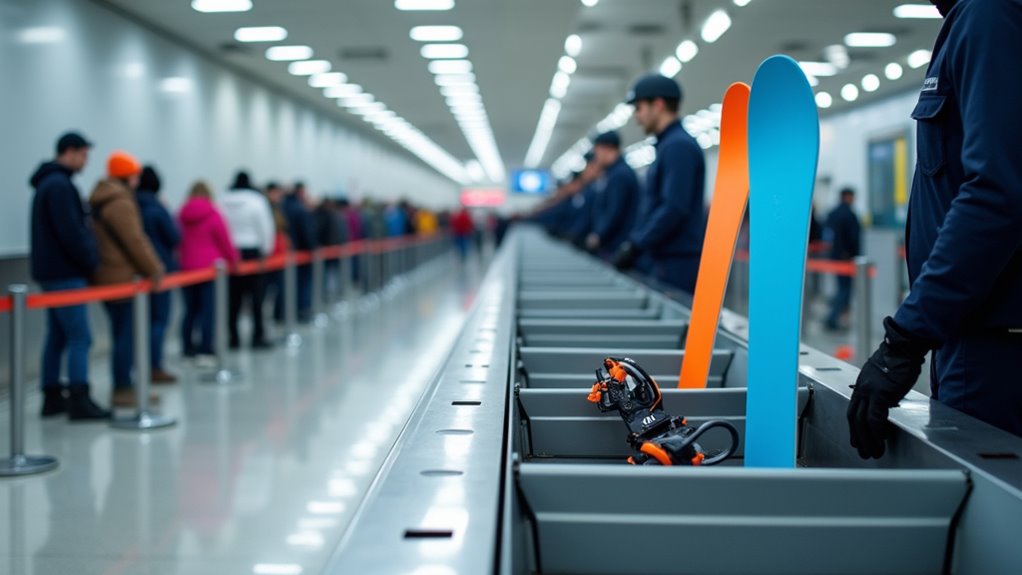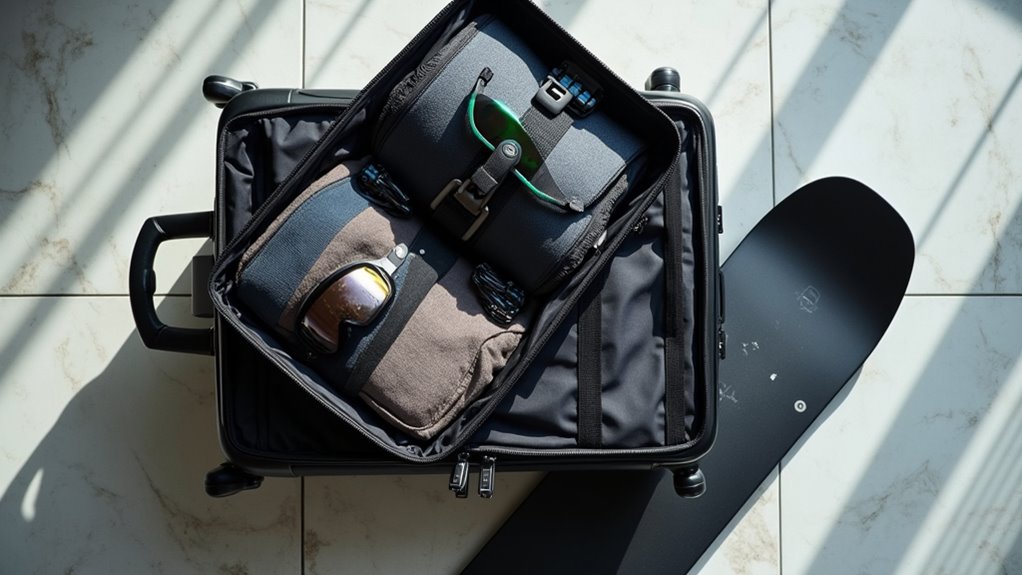Physical Address
304 North Cardinal St.
Dorchester Center, MA 02124
Physical Address
304 North Cardinal St.
Dorchester Center, MA 02124

Packing snowboards for air travel requires knowing hidden airline fees and special rules that could cost you hundreds unexpectedly.
You probably don’t realize that most airlines classify snowboards as oversized sporting equipment, which means they’re subject to entirely different baggage rules than your regular luggage. This classification can trigger unexpected fees, strict size limitations, and special handling requirements that’ll catch you off guard if you’re unprepared. Before you book that dream powder trip, there’s a specific strategy you’ll need to master to avoid costly surprises and guarantee your gear arrives intact.

Before you book your flight, you’ll want to dig into each airline’s specific snowboard policies since they vary dramatically between carriers. Some airlines treat snowboards as regular sporting equipment, while others classify them as oversized baggage with hefty fees. Check weight limits carefully—most cap snowboard bags at 50 pounds, but some allow up to 70 pounds.
Don’t assume your snowboard counts as your free checked bag. Many airlines charge additional fees ranging from $75 to $200 each way. Budget carriers often have stricter restrictions and higher costs than major airlines.
Look for airlines offering winter sports packages or seasonal promotions that waive equipment fees. Compare total costs including baggage fees, not just base ticket prices, to find the best deal for your snowboard trip. Consider packing lightweight camping tables in your gear if you plan to set up base camps during multi-day snowboarding adventures.
Once you’ve sorted out airline policies, you’ll need a bag that’ll actually protect your gear during the chaos of baggage handling. Don’t skimp on quality here – your board’s worth protecting.
Invest in quality protection for your board – baggage handlers aren’t known for their gentle touch with expensive gear.
Hard cases offer maximum protection but they’re heavy and expensive. Padded bags strike a good balance between protection and weight. Look for reinforced edges, thick padding around the tip and tail, and quality zippers that won’t break mid-trip.
Size matters too. Your bag should accommodate your board plus boots and bindings without being overstuffed. Wheels make airport navigation easier, especially with heavy gear.
Check the bag’s weight when empty – some add significant pounds to your luggage allowance.
Finally, choose bags with external pockets for easy organization of smaller items. While snowboards need structured protection, other gear like hammocks offer a lightweight alternative for jungle camping adventures where weight and packability are crucial considerations.

Even with the best travel bag, poor packing can leave your snowboard vulnerable to damage during transit. Start by wrapping your board in a towel or bubble wrap, focusing on the edges and bindings.
Place softer items like clothing between multiple boards if you’re carrying more than one.
Position boots at opposite ends to distribute weight evenly. Fill empty spaces with clothes, socks, or gear to prevent shifting during handling.
Don’t pack fragile items like goggles directly against hard surfaces – wrap them separately.
Keep bindings loose but secure to avoid stress on mounting points. Place heavier items like boots at the bottom of wheeled bags.
Finally, stuff the bag fully to prevent contents from moving around during rough baggage handling.
Just as camping shelters require proper setup to withstand harsh conditions, your snowboard bag needs strategic packing to protect against the rigors of travel.
While packing smart protects your gear, staying within airline weight limits saves you from hefty overweight fees that can cost $100 or more per bag. Most airlines allow 50 pounds for checked bags, so weigh your snowboard bag before heading to the airport.
Distribute weight strategically by splitting heavy items between your snowboard bag and regular luggage. Move boots, helmets, and extra clothing to your carry-on or personal bag. Keep essential gear like bindings and tools with your board for easy access during equipment checks.
If you’re traveling with others, coordinate weight distribution across multiple bags. Share bulky items like extra layers or après-ski clothing.
Consider shipping non-essential gear ahead if you’re consistently over limits, as this often costs less than airline overweight fees. Just like deciding whether to rent or buy equipment for your trip, weighing shipping costs against overweight fees helps you make the most economical choice.

Before you reach the gate, you’ll need to navigate security checkpoints where TSA agents may inspect your snowboard bag more thoroughly than standard luggage. Arrive early to account for extra screening time. Remove all electronics, liquids, and metal items from your bag beforehand. Sharp tools like edge tuners must go in checked luggage, not carry-on.
When traveling internationally, research customs regulations for your destination. Some countries require declaring sporting equipment or paying import duties. Keep receipts for expensive gear to prove ownership and avoid complications. Fill out customs forms accurately, listing your snowboard and accessories.
Consider getting TSA PreCheck or Global Entry to expedite the process. These programs considerably reduce wait times and make traveling with sports equipment less stressful.
Once you arrive at your destination, remember that proper preparation extends beyond just getting there – familiarize yourself with beginner snowboarding tips to ensure a safe and enjoyable experience on the slopes.
Although airlines remain the most common choice, shipping your snowboard separately can save you money and headaches. Ground shipping services like FedEx or UPS often cost less than airline baggage fees, especially for longer trips. You’ll avoid airport hassles, potential damage from rough baggage handling, and weight restrictions.
Ship your board to your hotel, resort, or a local FedX/UPS store for pickup. Pack it securely in a padded bag or box, and insure valuable equipment. Allow extra time for delivery – ship at least a week before your trip.
Car rentals work well for road trips, giving you complete control over your gear. Some rental companies offer roof racks or cargo boxes specifically for winter sports equipment, making transport easier and safer.
When packing your snowboard for any transport method, consider investing in quality protective gear like the Montane Featherlite Smock to enhance your overall winter sports experience.

Since snowboards can cost hundreds or thousands of dollars, you’ll want all-inclusive travel insurance that covers your gear. Standard homeowner’s or renter’s insurance typically won’t protect equipment while traveling internationally or during transit.
Look for policies that specifically cover sports equipment damage, theft, and loss. Check coverage limits—some policies cap gear coverage at $500, which won’t replace a premium board. Read the fine print about exclusions, particularly regarding extreme sports activities.
Document your equipment before traveling. Take photos of your snowboard, bindings, and boots, noting serial numbers and purchase receipts. Store this information digitally in cloud storage for easy access if you need to file a claim.
Consider upgrading to higher coverage limits if you’re carrying multiple boards or expensive gear. Just like preparing for camping experiences, thorough planning and protection of your valuable gear ensures you can focus on enjoying your adventure without worrying about potential losses.
When you’re traveling with snowboard equipment, you’ll need extra time at the airport for specialized processing and potential complications. Sports equipment requires additional screening, paperwork, and handling that standard luggage doesn’t.
Arrive at least two hours early for domestic flights and three hours for international travel.
Check-in agents must verify your equipment meets size and weight restrictions, which takes longer than regular bags. Security screening involves manual inspection of your gear, and oversized items often go through separate conveyor systems.
You might encounter delays if your snowboard bag needs re-inspection or if staff aren’t familiar with equipment policies.
Don’t risk missing your flight because of equipment processing delays. That extra time you’ve budgeted could mean the difference between a smooth departure and watching your plane leave without you. Consider packing a portable espresso maker in your carry-on to enjoy fresh coffee while waiting through the extended processing times.

While your snowboard and boots travel in cargo, you’ll want to pack critical backup items in your carry-on bag. Start with extra goggles and a face mask – essential gear that’s lightweight but vital if your checked bag gets delayed.
Pack lightweight essentials like goggles and face masks in your carry-on as backup gear when your snowboard travels in cargo.
Pack thermal base layers, wool socks, and gloves since these take minimal space but keep you warm. Include any prescription medications, contact solution, and personal items you can’t replace easily at your destination.
Don’t forget your lift tickets, resort maps, and emergency cash. Throw in some energy bars and a water bottle for mountain fuel. A portable water filter can be invaluable for backcountry adventures when you need access to clean drinking water from natural sources.
Consider packing a basic first-aid kit with bandages and pain relievers. These items guarantee you’re ready to hit the slopes even if your main luggage arrives late.
You’ve researched the policies, you’ve packed your gear, and you’ve prepared for every checkpoint. Now you’re ready to chase powder down epic slopes, carve fresh tracks through untouched terrain, and create memories that’ll last forever. Don’t let poor planning steal your adventure—follow these tips, protect your investment, and arrive prepared. Your snowboard’s counting on you, your mountain’s waiting for you, and your perfect trip depends on it.